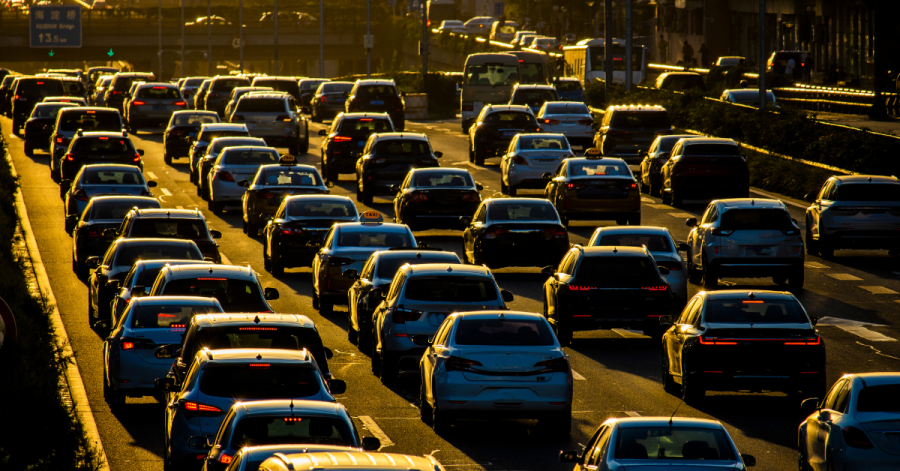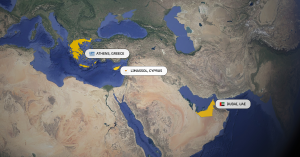Only have 1 minute? Here are 3 takeaways from the piece:
- As a key challenge in the transition to more sustainable transportation systems, cities in CEE are dealing with a rising populist movement, which tends to prioritize short-term gains and preserve the status quo – car-dependent cities.
- Initiatives aiming to encourage shared and micromobility are coming second to investments in expanding road infrastructure.
- However, recent developments in Sofia and Bucharest show how with the right policies and incentives, cities can reclaim urban spaces for their citizens and away from cars and air pollution.
The world is rapidly urbanizing, yet not without continuing challenges such as increased congestion, travel distances, and pollution. Transforming our cities through the lens of sustainable development is not an easy task. It’s particularly tricky in Central and Eastern Europe, where we face a mix of populist influences and a strong preference for owning and driving cars everywhere.
On the one hand, populist policies and leaders tend to prioritize short-term gains over longer-term plans and may resist transformative changes. On the other hand, in car dependent cities, people are resistant to giving up individual mobility options.
It’s in this context that many CEE cities are pressed by the EU green agenda to find a way to prioritize the development of green mobility infrastructure and services. The end goal is to give the city back to its citizens, rather than their vehicles, for better long-term quality of life. Recent developments in cities such as Bucharest and Sofia indicate that we are on the right track, yet there are still bears on the road.
Car dependent cities meet governments that promote short-term gains
Populist movements and parties have gained traction in several countries in Central and Eastern Europe. They tend to advocate for national sovereignty, emphasize traditional values, and challenge EU policies. CEE offers an easy ground for populism to spread, although not homogeneously, due to uneven economic development and the perceived influence of external actors, such as the EU. Populist actors often tap into public discontent with corruption, economic inequality, and perceived disregard for national interests by political elites and institutions.
It’s important to note however, that populist parties haven’t been well received everywhere in the region, and instead face criticism both domestically and internationally for their impact on democratic norms, rule of law, and civil liberties.
That said, populist governments tend to gain popularity due to resonating with the immediate needs and desires of the citizens. They succeed by prioritizing short-term goals, so they focus on policies that can bring quick results. They also tend to favor the status quo and tradition, making them more resistant to systemic goals such as sustainable development, which requires a long-term vision, comprehensive planning, and disruptive changes.
It’s then not surprising that, in the context of transportation, populist governments resonate with citizens who would rather keep the tradition already established in the region of owning and driving a car for their daily commutes.
Citizens in car dependent cities are accustomed to the convenience and comfort of their cars and thus may resist efforts to promote alternative modes of transportation. They often prioritize individual mobility and the flexibility it offers over the collective benefits of sustainable urban mobility systems. They may also perceive such changes as a threat to their lifestyle or a burden on their finances.
In East European countries, reaching the level of development of road infrastructure in the West – and thus favoring car travel across the country – has been a budgetary priority for years. On the other hand, projects dedicated to developing and improving public transportation such as railway and bus have been scarce and scattered. Initiatives that would limit private car usage, such as parking restrictions and bans for polluting vehicles have also been delayed for years from fear of backlash.
What is the 15-minute city all about?
Take the 15-minute city approach, for instance. The concept was popularized years ago by Sorbonne professor Carlos Moreno as a model for creating people-centered, sustainable cities. In the 15-minute cities, residents can access the places where they can fulfill their daily needs in no more than 15-minutes walking or biking distance. The result are compact and complex neighborhoods that include grocery stores, schools, healthcare facilities, workplaces, recreational areas, and cultural institutions.
I certainly think of Rotterdam from my personal experiences, yet many cities such as Paris, Barcelona, and Melbourne have designed urban plans that encourage the 15-minute concept. They include pedestrian-friendly streets, accessible sidewalks, dedicated cycling lanes, public transit infrastructure, green spaces, the presence of small, neighborhood shops,
Implementing elements of the 15-minute city approach would reduce car use, congestion, air pollution, and carbon emissions, while fostering social interactions, convenient access to amenities, saving time from commutes, and living a more active lifestyle.
Kaloyan Karamitov, part of Sofia’s team and City Living Lab Manager at GATE Institute, illustrates the benefits for cities of transitioning from cars to alternative modes of transportation:
“Cars, as a transportation mode, are the least efficient in terms of utilization of space in the city. One car is roughly 10 sq.m. and typically has only one passenger – the driver. In comparison, the bus with 30 seats has an area of 30 sq.m., while a pedestrian needs less than 1 sq.m. The transition from car dependency towards other more sustainable modes of transportation would lead to fewer cars and respectively less occupied space. Instead of parkings or parked cars in violation in the areas around the buildings, there could be wider, more convenient and safer sidewalks, cycle lanes, small pocket gardens with benches to relax and enjoy the city streets, places to talk to your colleague, friend or neighbour. The inner neighbourhoods could have more sportsgrounds, playgrounds, or parks. Furthermore, fewer cars would bring back a certain level of calmness to the street – less noise and pollution, fewer heavy vehicles passing around. Cities with lower motorization levels also have fewer accidents and victims on the road.”
Yet the concept has been met with skepticism and fear by citizens who feel their rights for driving personal vehicles are being threatened. These fears found their way into local governments, who are increasingly influenced by the change-resistant populism, as well as traditionally dependent on the automotive and fossil fuel sectors. Across Central and Eastern Europe, energy sectors rely heavily on gas and coal, while the automotive industry is booming, with a growing number of car manufacturers establishing their modern and state-of-the-art production sites in the region.
Much like all green mobility and sustainable city initiatives, implementing elements of the 15-minute city depends heavily on a successful collaboration among urban planners, policymakers, community stakeholders, and residents. It takes strategic land-use planning, investments in developing and improving existing infrastructure, devising incentives toward alternative mobility, and imposing certain limits.
How to lead the transition to more sustainable cities
If there’s one starting point for governments and municipalities in the transition to sustainable urban planning and transportation systems, it’s raising awareness about the advantages of these models. Citizens need to be informed about the environmental, economic, and health benefits of living in a sustainable city. To achieve this level of education, public authorities can invest in targeted campaigns, as well as make sure the topic is included in relevant public education curricula.
“The administration (of Sofia, Bulgaria, ed.note) should work on creating a carless mobility culture. The shift should not be imposed but rather made popular and desired among the people. Creating and following a long term communication strategy which is innovative and creative and explained to different users and demographic groups. The sustainable forms of mobility should be made “cool” and attractive along with being the environmentally friendly choice,” says Kaloyan Karamitov.
On the policy side, recent developments in Eastern European capitals such as Sofia and Bucharest are paving the way to citizens reclaiming their cities from cars and carbon emissions. Both cities have restricted parking to only designated areas, by introducing fines or impounding your car, with the goal of freeing streets and walking lanes from unwanted cars.
Bucharest has also started closing some of its central boulevards to cars during summer week-ends, opening it to long walks and street festivals. Meanwhile, Sofia is planning to prohibit the access of the most polluting cars in the city center starting December 1st, 2023. The first category of vehicles targeted includes diesel cars that are over 20 years old and gasoline vehicles over 30 years old. One year later, the same restrictions would apply to cars from the second environmental group.
Then, there’s a need for planning, and budgeting that favor the development of infrastructure for green and shared mobility modes, including pedestrian-friendly areas, cycling lanes, bus routes, rail infrastructure, and electric vehicle charging stations. In the absence of optimal infrastructure, it is difficult to make the case for the benefits of transportation alternatives to private vehicles.
“The motorization rate in Sofia has been growing in the last few years. The main project is expanding the metro system but the data shows that it is not enough. Efforts must be made on the ground level – optimizing the route network of trams, trolleys and buses to be tailored to the current demand and hot spots that attract people’s movement. This is of utmost importance since the current transportation route scheme is decades old with just small and insignificant changes that do not respond to the spatial development of the city. Sofia has enough strategic documents that lay a strong foundation of sustainable mobility with specific projects that guide in this direction. The implementation of these documents needs to be initiated and the results will follow,” Karamitov adds.
Finally, it will surely also require the introduction of mechanisms that encourage citizens to make the switch sooner rather than later. People need to have relatively easy and affordable access to public transport or micro- and e-mobility. In Sofia and Bucharest, for instance, we noticed micromobility programs in partnership with private companies such as bike- and scooter-sharing services, subsidies for electric vehicles, and public transportation systems with digitized payments.
“This transition needs measure in both directions – restrictive and encouraging. The restrictive measures should be towards the cars – introducing low emission or congestion zones, regulated parking, paid parking spaces, limitation of the polluting fleet of cars, dedicating car lanes to buses, trams or cycles etc. The encouraging measures should work towards making the sustainable modes of transport more convenient, fast and safe to be a realistic alternative to the car and attract more users,” Kaloyan Karamitov concludes.
Only with such a holistic approach to urban planning and mobility, can we ensure a gradual and balanced transition to greener cities.








